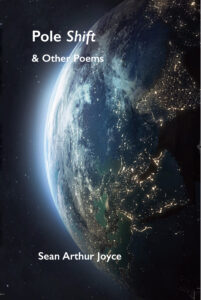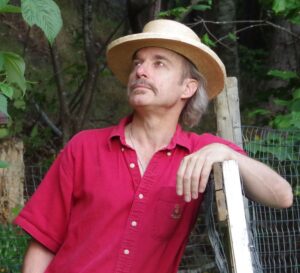When ‘we cultivate the Lucifer/inside’
Pole Shift & Other Poems
by Sean Arthur Joyce
Victoria: Ekstasis Editions, 2024
9781771715560 / $23.95
Reviewed by Joe Enns
*

Pole Shift & Other Poems, the seventh collection of New Denver-based Sean Arthur Joyce (Blue Communion), is a book about social ethics and outrage in the shadow of history at a galactic scope. Joyce attempts to intersect sociology with cosmology, astronomy, mythology, and ecology all while posturing himself as the proverbial tortured artist (“the lonely poet flicker’s out,/a pinched candle stub”).
In Pole Shift & Other Poems, the poems are set in four parts with corresponding front and back matter to contextualize the poems. Joyce includes an “Introduction” where he explains the premise of the book and makes an argument for his poetry considering past critiques. After the poems, Joyce includes a “Notes on the Poems.” There, he spells out the volume’s mythological or historical reference. Then there’s an “Appendix: Scientific References,” where Joyce quotes literature about Earth’s pole shift. Finally, Joyce includes “Endnotes” that clarify citations made in the poems. I mention all this because the extensive material show what Joyce is trying to do with this book and how he views the reader. It’s similar to explaining a joke before you tell it. Sure, the audience might learn something, but the joke loses its impact. In the same way, Joyce subverts any sort of discovery or insight the reader might have on their own by assuming the reader won’t see his references otherwise.
Joyce’s premise: not only is the Earth’s magnetic field shifting, but that shifting is increasing, and at times in history the polarity completely flipped. Does this underlying change in the magnetic field account for a drastic change in human behaviour? Much of Joyce’s poetry Pole Shift resists concrete sensory imagery, and relies instead on abstraction and aphorism as he describes the world not as a physical thing, but as a field of mindsets in the same way the magnetic poles underpin the Earth. The world is continuously reborn as part of a cycle, and humanity is “birthed in light, to baptize/a drowned world.” Joyce uses the baptism symbolism throughout.
The last time I saw my family doctor, I was surprised to see a large pink crystal on his desk. Then he told me I could just google my health issues. The modern question: science or pseudoscience? Joyce’s poetry reminds me of the crystal on my doctor’s desk. The interchange between physics (and metaphysics) and social ethics confuses me in Pole Shift. Joyce illustrates the evils of human nature, the predatory elites, and social engineers (“ersatz divinities in lab coats/shred life’s blueprint, reaching/for eternity, ignorant of the field/strewn with prestigious corpses”) who control the “weak-spirited” masses through cultivated micro-divisions.
But what exactly is Joyce’s virtuous, hyperbolic ranting aimed at?

Joyce describes a “full spectrum dominance/the doctrine of devils whose/gnarled humps hunch over chessboards/in the grand game of Holocaust.” But if “errant” human behaviour is part of a repeating cycle, the Wheel of Fortune (assuming society is near the bottom of the “Wheel” right now), and that cycle is caused by innate and immutable astronomic forces, what is Joyce reeling against? One only needs to watch the cycle turn back up towards the positive, until we’re reborn or baptized again. Although even the baptism symbol becomes muddy. Baptism generally represents a change in the convert, but in Joyce’s poetry, the world is reborn, and mankind revolves alongside (“roll with the compass”). From COVID-19 to Gaza to Julian Assange to Silent Spring, in an effort to create a “poetry of relevance,” Joyce isn’t a rebel without a cause, he’s a rebel with every cause.
The first section, Pole Shift, composes about half the collection and is what the “Introduction” refers to. Joyce pays close attention to phrase and sound, each line concise to phrase length of five to ten syllables with full use of assonance and alliteration always grasping for the profound. The early 1900s register mixed with modern diction purposely creates a biblical voice, an Old Testament prophet or preacher set on his soapbox: “when we cultivate the Lucifer/inside, elevate ourselves/to be the “Shining One”/at God’s right hand.” In terms of form, many of the poems are free verse, or set in tercets or quatrains. “Seed of Life” is made up of tercets with repeating lines similar to, but not as strict as, a villanelle or pantoum. The poem represents a pattern of three, like the vesica piscis (referenced in an epigraph): two overlapping shapes that create a third shape. I know this because Joyce poetsplains it in an endnote along with a link to a “sacred geometry” website.
Joyce begins the book with an epigraph from Rainer Maria Rilke that talks about breaking down the walls between us with a cry. In the “Introduction,” Joyce says that “society is more divided than possibly any time in history.” But throughout the collection Joyce sentimentally exaggerates the hypothetical Us versus Them mentality. God and Lucifer. The working class versus the greedy corporate elite (“the prayers of billions/try to lift the dead weight/from our brows, to no avail”). The tortured artist versus the mediocre. Pole Shift & Other Poems attempts to show a directional spin (“you don’t know one hand/from the other. Left is right,/right is left) and a disorientation of social ethics.
The collection also posits a certain optimism, of society returning to the light (“let the sky regain its sanity in its own time”); this hopefulness is often embedded in closing lines and is overshadowed by the “Lake of Fire” and “demons of ideology.” Joyce also meditates on a love for nature in the second part, Odes to the Earth II, which changes the tone and contrasts from the Pole Shift section. The final part, House of Blues, contains many of the strongest poems, such as “Look Ma, I Saved the Flowers,” an ekphrastic poem that effectively uses the imagery from a painting to evoke the much broader and complex notion of futile acts in relation to a calamity.
While Pole Shift & Other Poems is an ambitious work that takes the heaviness of world events on its shoulders, Sean Arthur Joyce undermines the epiphanies through poetsplaining and posing himself as the modern-day biblical prophetic speaker (“Courage! No demon exists/beyond dogma’s hypnosis,/the shrill bleat of a shocked herd”), which often comes across as condescending. Or maybe I’m just weak-spirited.

*

Joe Enns is a writer, painter, and fisheries biologist on Vancouver Island. His writing has appeared in The Dalhousie Review, FreeFall, The Fiddlehead, GUSTS, and Portal Magazine, and book reviews in Event, Malahat Review and The British Columbia Review. Joe has a BA in Creative Writing and a BSc in Ecological Restoration. [Editor’s note: Joe has reviewed Cathy Stonehouse, Clint Burnham, Nadine Sander-Green, Spenser Smith, Rodney DeCroo, Barbara Pelman, Karl Meade, M.W. Jaeggle, Ali Blythe, Emily Osborne, Will Goede, and Evelyn Lau for BCR.]
*
The British Columbia Review
Interim Editors, 2023-25: Trevor Marc Hughes (nonfiction), Brett Josef Grubisic (fiction and poetry)
Publisher: Richard Mackie
Formerly The Ormsby Review, The British Columbia Review is an online book review and journal service for BC writers and readers. The Advisory Board now consists of Jean Barman, Wade Davis, Robin Fisher, Barry Gough, Hugh Johnston, Kathy Mezei, Patricia Roy, and Graeme Wynn. Provincial Government Patron (since September 2018): Creative BC. Honorary Patron: Yosef Wosk. Scholarly Patron: SFU Graduate Liberal Studies. The British Columbia Review was founded in 2016 by Richard Mackie and Alan Twigg.
“Only connect.” – E.M. Forster
One comment on “When ‘we cultivate the Lucifer/inside’”
Editor’s note: We have received the following comment by email from Art Joyce — Richard Mackie, publisher, The BC Review
*
Rebuttal to Joe Enns’ “Review” of Pole Shift
Sean Arthur Joyce
Joe Enns’ hatchet job on my new book, Pole Shift & Other Poems, masquerading as a review, requires some rebuttal. By my inclusion of an Introduction and a “Notes to the Poems” in the appendices to Pole Shift, Enns assumes I have a condescending, “poetsplaining” attitude to the reader. I’ve regularly included such features in my 7 poetry collections, since I’m a lifelong student of mythology and realize that obviously not everyone is reading the same texts I am. I remember as a young man reading—or trying to read—Ezra Pound’s Cantos and being stumped by many of the arcane references. To me it’s more condescending to assume your reader has the same education you do, or throw around references merely to make yourself appear erudite. It’s a form of elitism in literature—something I’ve fought against my entire career.
Here’s what Tom Wayman has to say about the mainstream academic bias against writing Introductions for poetry collections: “My (new) poetry book sections have prose intros—I know the ‘pure’ poets don’t like that, because in making poetry accessible you implicitly are arguing for poetry with a wide audience, whereas they want poetry to be the preserve of an elite. They have a whole career invested in obscurity.”
Enns clearly didn’t understand that because I was inspired by certain terrestrial and cosmological events that many readers may not be aware of, I felt I should provide some background context. There are obscure scientific references in Pole Shift, for example, the Laschamps excursion, the use of Beryllium-10 to date magnetite samples, etc. Many readers may also not be aware that we’re currently undergoing a geomagnetic pole reversal. I didn’t want to risk in readers the reaction I had to Pound’s Cantos, giving up in frustration due to its obscure references. And at this stage of the 21st century, I don’t think it’s any stretch to say that in these times of what some have called “functional illiteracy,” what may once have been common cultural references—for example Biblical allegories—are no longer common parlance.
Further, by his flippant and irrelevant reference to the pink crystal in his doctor’s office, Enns insinuates that I’m indulging in pseudoscience. Not true—this is why all the scientific references are footnoted (Endnotes section), and all are from mainstream scientific publications. He seems to take exception to the one poem that references sacred geometry, but this only betrays his ignorance of history. The principles of sacred geometry were used to build all the great cathedrals in Europe, securing its place in the history of architecture.
By implication, Enns seems to take exception to the political nature of many of the poems, reflecting a longstanding bias in Canadian creative writing faculties that such poetry is somehow beneath an educated poet. The late Patrick Lane once decried the lack of a tradition of dissent or political satire in Canadian poetry, but this reflects the bias of the academic establishment who would prefer that to be the case, not the reality. Even our rather more sedate Canadian tradition includes political poets such as Irving Layton and Milton Acorn. I would urge Enns and others of his ilk to go back and read Acorn’s “I Shout Love,” which isn’t afraid of strong declarative statements calling out murder and corruption. Irving Layton, in “Whom I Write For,” put it this way:
When reading me, I want you to feel
as if I had ripped your skin off;
Or gouged out your eyes with my fingers;
Or scalped you, and afterwards burnt your hair
in the staring sockets…
The pertinent question here is: Who benefits from discouraging political content in art? It plays nicely into the agenda revealed in Joel Whitney’s exposé, Finks: How the CIA Tricked the World’s Best Writers, in which he revealed that the first Abstract Expressionist exhibitions—and the early postmodernist movement—were funded by that agency as part of its foreign cultural program. “A use for culture had finally been found: it was a weapon… Like the New Critics’ ahistorical approach to a text, the paint splashes of Jackson Pollock did not lend themselves to a Marxist or anti-imperialist narrative the way Diego Rivera’s sweeping murals did.” Incredibly, generations of artists, poets, and university professors were taken in by this deliberate misdirection, which itself had a political motive, as George Orwell wrote: “The opinion that art should have nothing to do with politics is itself a political attitude.”
Further, it ignores the wide and deep history of the political in poetry going back 5,000 years to the Epic of Gilgamesh, which satirized the excesses of a Sumerian city-king. This trope resonates right through the classical Greek tradition of poets and playwrights, down through the millennia to the present era. Chaucer’s Canterbury Tales and Boccaccio’s Decameron satirized the excesses and corruption of the church. Shakespeare, writing during a particularly dangerous period in English politics, had to be more subtle, using earlier monarchs from that history to obliquely comment on the power politics of the Elizabethan age.
Apparently Enns ignores even more recent examples of this tradition, for example Beat poets Ginsberg, Ferlinghetti, Levertov and others. In my Introduction to Pole Shift, I quote from Ferlinghetti’s brilliant little book, Poetry as Insurgent Art: “If you would be a poet, create works capable of answering the challenge of apocalyptic times, even if this means sounding apocalyptic.” Ferlinghetti’s political verses were always tempered with love and playfulness.
Enns seems oddly mystified at the target of my “rants” but the subjects are quite clear, as in the poems “The Screaming Towers” and “Lament for Gaza.” More generally, Pole Shift indicts the alarming shift toward censorship and authoritarianism in the West, particularly since Covid. As the saying goes, if you’re not enraged by this, you’re not paying attention. Gary Geddes, one of the last remaining true gentlemen of literature still capable of entertaining opposing points of view without succumbing to apoplexy, has said of some of my poems that they occasionally lapse into the “voice of an Old Testament prophet.” Fair enough. In my Introduction to Pole Shift I admit: “Is diatribe effective in poetry? Probably not, but then it’s not meant as a rhetorical tool to convince people of anything. It’s a cry from the gut of wild animal rage at atrocity.” Atrocity is not something we ought to respond to politely.
Enns criticizes the poems in Pole Shift for “always grasping for the profound,” again reflecting the underlying bias of mainstream poetical thought that such an urge is now considered passé, as if only the personal, pedestrian and mundane are apt topics for poetry now. This is a pitiful worldview, a tacit adoption of nihilism—the sense that all in life is essentially meaningless and those who try to create meaning from it are presumptuous. Art is fundamentally a meaning-making activity and always has been. Artists ought not to be dispassionate observers—not scientists—but eloquent, erudite souls driven by love and passion to create art that actually touches people.
In this context I consider myself a New Romantic. In an essay I published in the peer-reviewed journal Canadian Poetry in 2015, and later in the British journal Acumen, “A New Romanticism for the 21st Century,” I argue that the retrospective condemnation of Romantic poetry is based on the modernist fallacy of progressivism in literature. The fact is, millions of people read and loved the poems of Blake, Keats, Byron, Shelley, Wordsworth and Tennyson and still do 150 years later. The fact that these poets often “grasped for the profound,” employed aphorism, spiritual abstractions or declarative statements, is hardly a reason to dismiss their work. How many of today’s poets will people be reading and quoting in 150 years?
This brings me to another of Enns’ criticisms, that much of my poetry in Pole Shift “resists concrete sensory imagery, and relies instead on abstraction and aphorism.” This is pure cherry-picking to support an argument. Certainly, the title sequence is primarily dealing with political and social issues, but even here I’ve woven in concrete imagery: “Lighthouse keepers a damp / imprint of salt on a sea-bashed tower.” (Pole Shift, II) “A lake’s clear / lens stares back at us through blue / remembrance…” (Pole Shift, V) “Time’s red ochre flashbulb / of handprints on a Lascaux / cave wall…” (Pole Shift, VI) And this is just the title sequence. There are plenty more examples throughout the book if Enns had only bothered to notice.
Tom Wayman once said: “Poetry is a big tent. There’s room for everyone.” Aesthetics in art is just a vehicle for communication. If it fails to communicate to an audience, the motto of the British Columbia Review, “only connect,” is subverted, resulting in alienation. Such poetry becomes a kind of elitist cult only accessible to those initiated in the clique.
From the beginning of my career as a poet, starting in the late 1980s when I was touring with Chad Norman and other West Coast poets, my goal has been to advocate and write for a “poetry for the people,” just as Layton and Acorn did. As Wayman says, this doesn’t go down well with the poetry elitists. Yet I’ve lost count of the times I’ve had audience members come up to me after one of my readings and say, “Wow—that poem really touched me, thank you.”
That’s where the rubber meets the road. That’s connection.